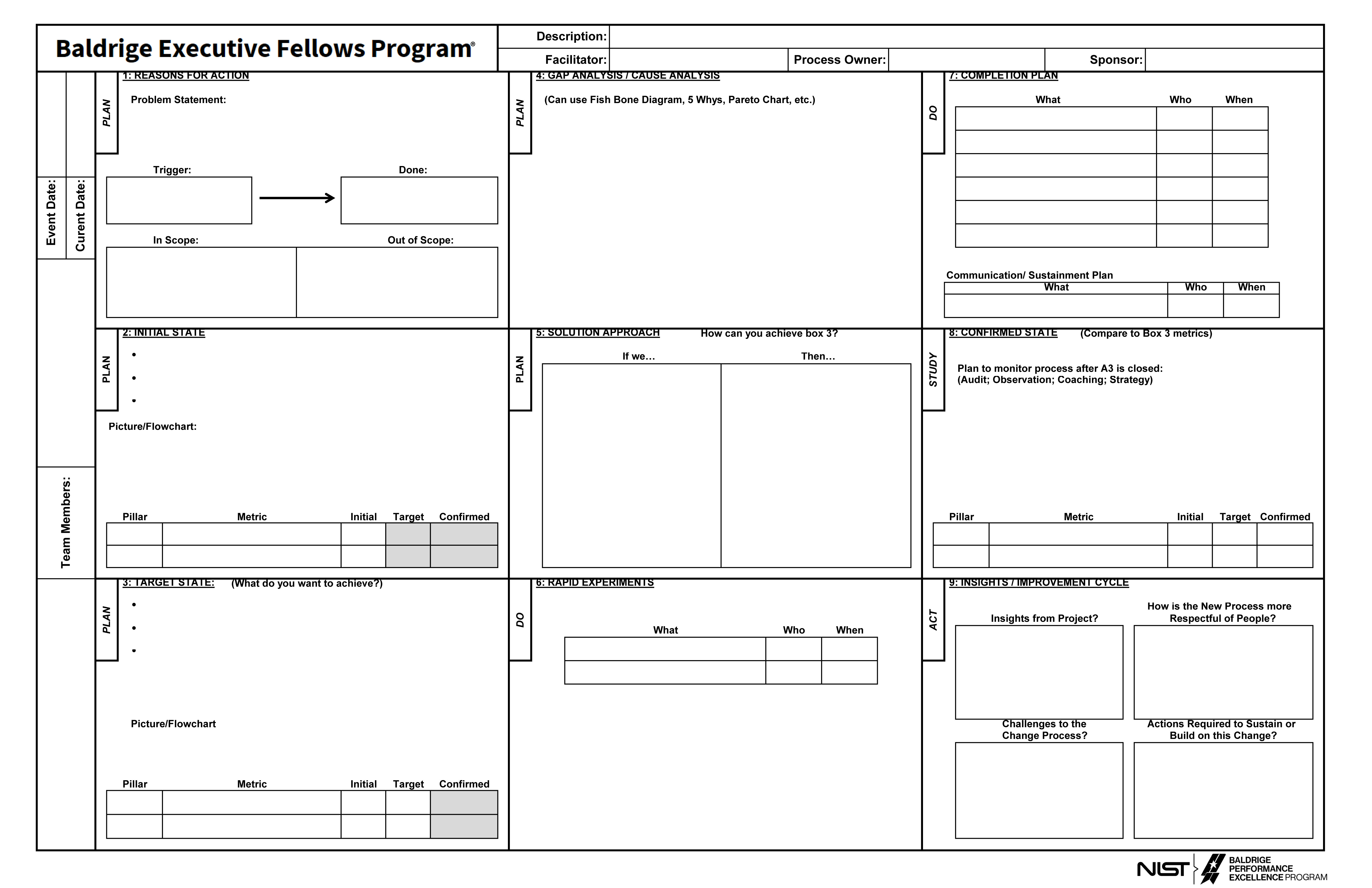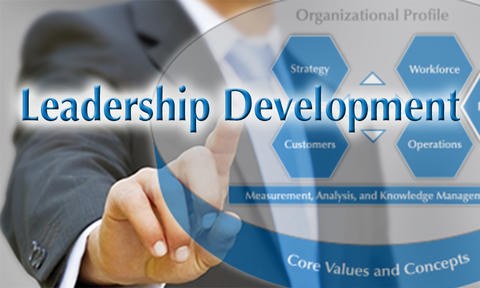Blogrige
The Official Baldrige Blog
The Baldrige Executive Fellows, Capstone Projects, and the A3 Problem-Solving Tool

The Baldrige Executive Fellows are an annual cohort of executives learning about leading their organizations using the Baldrige Excellence Framework® as a guide. As part of the collaborative experience, each executive fellow undertakes a capstone project of strategic significance to their organization. For more than a decade, the fellows have used the A3 problem-solving tool to guide their capstone project definition, planning, and execution. It has proven to be an extremely valuable tool. It is worth considering by all organizations with problems to solve.
The A3 tool was first introduced to the fellows by Pattie Skriba, former VP of business excellence for Advocate Good Samaritan Hospital, with more recent instruction provided by the Lean Transformation Office of WellStar Health System, and his colleagues. I will describe the tool and discuss how it helps avoid some frequent pitfalls in problem-solving.
The A3 Tool—Problem Definition
The tool used by the fellows is a 9-box problem-solving tool. This blog contains a brief overview of each box.

Box 1 contains the problem statement. What problem are you trying to solve, and why is it important? A common pitfall is a problem statement that proposes a solution before the root cause of the problem is understood.
An example of a problem statement with this pitfall: First-line managers need to better coach their employees to improve employee engagement. The actual problem statement might be this: Employee engagement scores are low; raising engagement might address our high turnover rate. The latter statement allows exploration of ways to improve engagement. It does not assume that the answer is to have more effective coaching.
Box 2 defines the current state. What are the symptoms of the current problem? What measures indicate your current poor performance? Are there trend data indicating declining performance? Are there relevant comparisons that indicate your poor performance relative to competitors or benchmarks? If the problem is an ineffective or inefficient process, you could include a current process map.
Box 3 identifies your desired future state. What will success look like in qualitative and quantitative terms? How will your organization perform when the problem is solved? What will performance metrics look like when the problem is satisfactorily resolved? Will the measures you identified in box 2 have results that are 100% better than now, for example?
The A3 Tool—Planning the Improvement
Box 4 contains your root cause or gap analysis. What are the possible causes for the gap between boxes 2 and 3? What are the potential root causes of the problem you identified in box 1? Helpful tools for performing this analysis might be the five whys, fishbone diagrams, or Pareto charts. Remember that there may be more than one root cause that needs addressing or one root cause that should be a focus for your improvement.
Box 5 contains potential solutions to test. Box 5 is about hypotheses. Identify potential solutions for each root cause. Several root causes may have the same potential solution. Some solutions may yield much greater improvement than others. Some solutions may need to be executed in parallel to gain the benefit desired.
The A3 Tool—Problem Solution
Box 6 contains rapid experiments. Plan an experiment for each proposed solution. Design experiments with measurable results to see if they are positive predictors of achieving your desired (Box 3) state. Learn from your experiments and conduct additional rapid experiments, if needed. If none of your experiments yield positive results, return to boxes 5 and 6 to seek additional root causes or potential solutions. Communicate and share the results of your experiments with those who will benefit from solving the problem.
Box 7 is your completion plan to solve the problem. It is based on the positive experimental outcomes from box 6. Include an action plan with a timeline indicating: what will be done, who will be responsible and involved, how progress will be measured, and completion dates for each action. Your completion plan should include a communication plan and a plan for sustaining the outcome.
The most common pitfall is jumping from box 1 to box 7. We are always eager to solve problems, and the temptation is great to skip boxes 2–5, thinking we know the answer. This could lead to a lot of wasted effort and resources, and result in great disappointment.
Box 8 is about confirmation of achieving the desired outcome/state. It summarizes what you have accomplished: metrics for the initial state, the target state, the actual result, and multiple confirmations of sustaining the performance (e.g., 30-, 60-, and 90-day results measures). If results are not sustained, you will need to re-examine earlier boxes.
The A3 Tool—Learning
Box 9 contains insights and lessons learned. What went well? What might you do differently next time you use the A3 tool? What impact has the outcome had on key internal and external stakeholders? What have you learned about change and resistance to change?
An Example
If you are asking why you should use the A3 tool, let me give you a real-life example. A hotel was experiencing customer complaints due to cold and late delivery of room-service food. The average delivery time was measured (current state). The desired delivery time after food preparation was known (desired state), and the temptation was to explore the food preparation and delivery process and fix it (jumping to box 7). By using the five whys (box 4), the real problem was identified, solutions were tested, and the problem was solved. The root cause was a shortage of bed linens. Let's look at the five whys: Why was food late and cold? Because delivery staff were waiting long times for an elevator. Why were they waiting long times for an elevator? Because the elevators were being locked on the floor with the laundry. Why were they being locked on the floor with the laundry? So linens could be delivered to rooms with guests waiting to check in as rapidly as possible. Why were guests waiting to check in? Because there was an insufficient supply of linens; they had to be washed, pressed, and immediately returned to guest rooms. The solution to late and cold food? Buy additional linens!
What are your organization’s vexing problems? What are the real solutions to those problems?
Join a Community of Visionary Leaders

Become a Baldrige Executive Fellow
The Baldrige Executive Fellows Program is a hands-on leadership development program that will propel your organization to higher levels of performance. Learn from a cohort of senior decision makers and Baldrige Award recipients and emerge with a broader perspective on how to achieve performance excellence for your organization, stimulate innovation, and build the knowledge and capabilities necessary for organizational sustainability.
About the author
Related Posts
Comments
VERY nice!! Next time I have to wait too long at a restaurant, I'll be sure to ask if they are adequately stocked on bed linens. 😉






Nice article highlighting how A3 thinking can be applied in any industry to help teams solve problems.